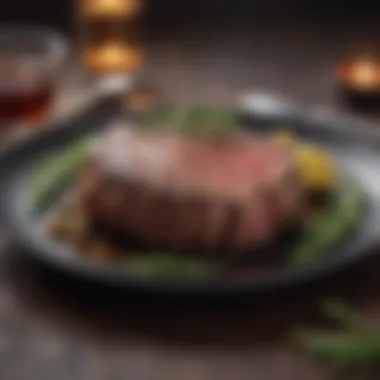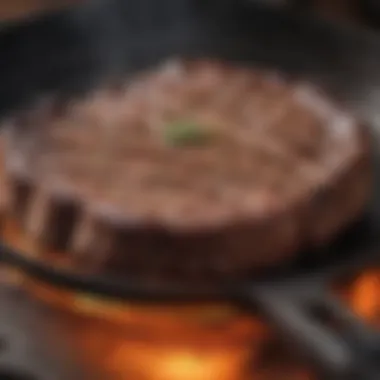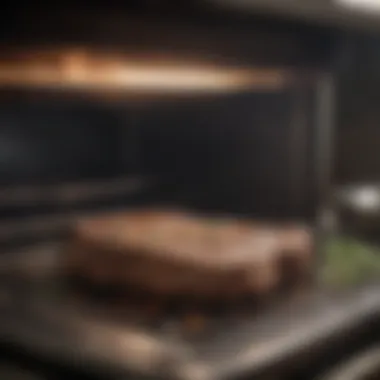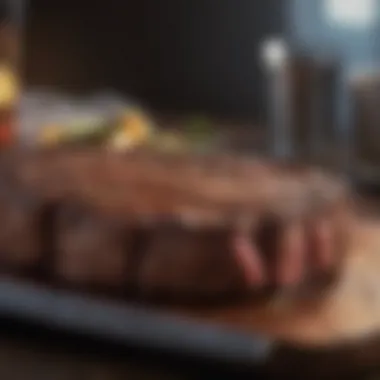Mastering the Art of Reheating Steak


Intro
Reheating steak is often viewed as a simple task. Nevertheless, it is an act that requires a thoughtful approach to truly maintain its original flavor and texture. Steak, when properly cooked, is tender and juicy. However, when reheated incorrectly, it can become dry or tough. Understanding how to effectively reheat steak involves exploring various methods that cater to different needs and situations. This article will delve into these methods, helping not only to retain the quality of the steak but also enhancing culinary skills.
Key Takeaways
- Various methods of reheating steak exist, each with unique pros and cons.
- Temperature control is crucial; reheating at low temperatures helps preserve moisture.
- Utilizing simple techniques, such as stovetop and oven reheating, can improve the eating experience of leftover steak.
Methods of Reheating Steak
Reheating steak can be accomplished through different methods. Each method has specific techniques and considerations:
- Oven Reheating: This is one of the most recommended approaches. Setting your oven to a low temperature, such as 250°F (120°C), can allow for gradual reheating. Place the steak in a baking dish and cover it with aluminum foil to avoid it drying out. This method retains juice and flavor effectively.
- Stovetop: Another common technique involves reheating steak in a skillet. Using a little bit of oil or butter, heat the skillet on low to medium heat. Sear the steak on each side for a few minutes, ensuring it warms evenly. This method adds a slight crispness to the steak's exterior.
- Sous Vide: This method uses water immersion to heat the steak slowly at a precise temperature. Sous vide will yield the best results in terms of maintaining moisture and tenderness. However, it requires specific equipment, which may not be available to all.
- Microwave: Though convenient, high temperatures in the microwave can lead to uneven cooking. If opting for this method, place a damp paper towel over steak to help retain moisture, heat it in brief intervals, and check frequently.
In-Depth Analysis
Reheating steak without proper methods can lead to a disappointing experience. The science behind moisture retention lies in understanding the properties of meat proteins. When reheating, proteins can contract and lose moisture if not done carefully. Choosing the right method aids in maintaining the steak's integrity.
Research supports that low and slow reheating offers the best outcome. A study indicated that meats retain more moisture and flavor when heated gradually. This principle aligns with both stovetop and oven techniques.
"Reheating at lower temperatures can help preserve the taste and texture of meats, leading to a more enjoyable meal."
Understanding the Importance of Proper Reheating
Reheating steak may seem like a trivial task. However, the method you choose significantly impacts the quality of the meat. Understanding the importance of proper reheating is essential for maintaining flavor and texture. When steak is reheated poorly, it often becomes tough or dry, leading to an unsatisfactory dining experience. This section delves into the critical elements surrounding effective reheating techniques.
Impact on Texture and Flavor
The texture and flavor of steak are primary indicators of its quality. Reheating it correctly helps preserve the juiciness and tenderness that many appreciate. After being grilled, roasted, or pan-seared, steak develops a specific mouthfeel that is synonymous with freshness. If reheated improperly, steak can lose that valuable characteristic.
Key factors include:
- Temperature: Using high heat can cause the outside to become overcooked while the inside remains cold.
- Duration: Prolonged reheating may lead to a loss of moisture.
Even subtle variations can produce noticeable differences in texture and flavor. For example, reheating at a low, steady temperature preserves more juices compared to aggressive heat. This attention to detail not only enhances taste but also creates a more pleasant dining experience.
Safety Considerations
Food safety is a crucial aspect often overlooked in reheating practices. Steak, like all meat, can harbor harmful bacteria if not handled correctly. Proper reheating is necessary to ensure any potential pathogens are eliminated. This involves heating the meat to the right internal temperature.
The USDA recommends reheating cooked steak to an internal temperature of at least 165°F (74°C). Using a food thermometer helps guarantee this standard is reached. Additionally, consider these safety guidelines:
- Storage: Ensure leftover steak is refrigerated promptly after cooking to minimize bacteria growth.
- Reheating: Avoid multiple reheating cycles, as they can further compromise food safety and quality.
Understanding these safety considerations protects your health while enjoying stored meat, ensuring that reheated steak remains both delicious and safe.
Choosing the Right Method
Selecting the appropriate method for reheating steak significantly influences the final result in terms of flavor, texture, and overall satisfaction. Understanding various techniques allows one to thoughtfully approach the reheating process and make informed choices based on individual preferences and available resources. This consideration is crucial, particularly because reheating can alter the integrity of the meat. Each method offers unique advantages and trade-offs. Thus, knowing these factors enhances the whole dining experience.
Oven Reheating
Oven reheating is a popular choice because it allows for even heat distribution, preserving the steak's original quality. This method is effective in achieving a better texture compared to other methods.


Steps to Follow
- Preheat the oven to the desired temperature, often around 250°F (120°C).
- Place the steak on a baking sheet lined with foil for easier cleanup.
- If available, cover the steak with another piece of foil to prevent excess drying.
- Reheat for about 20-30 minutes, checking for doneness.
Following these steps ensures a gentle reheating, maintaining moisture while allowing the steak to warm thoroughly. The slow heating process is essential as it minimizes the risk of drying out the meat, making this method a reliable choice.
Optimal Temperature
The optimal temperature for reheating steak plays a critical role in flavor retention. A moderate temperature of around 250°F (120°C) is recommended.
This temperature is beneficial because it gently warms the meat without cooking it further. A lower temperature is essential to prevent a rubbery texture, a common issue with higher heat settings. Therefore, controlling the temperature is vital for enhancing the overall quality of the meal.
Time Required
The time required for oven reheating can vary but typically ranges from 20 to 30 minutes. Longer times at lower temperatures help to achieve an even warmth throughout the steak. This characteristic is beneficial because it allows enzymes and flavors to meld gently without altering the steak's original properties too drastically. However, the downside is the need for patience, especially when compared to faster methods.
Stovetop Reheating
Stovetop reheating is another effective method. It often yields satisfying results but does require careful attention to avoid overcooking.
Best Practices
When reheating steak on the stovetop, using a skillet on low to medium heat is advisable.
The meat should be heated slowly, with occasional flipping to ensure even warming. This practice minimizes the chance of burning or drying out the steak. The unique feature of this method is the control it offers; however, it requires active monitoring, which could be seen as an inconvenience for some.
Use of Cooking Oil
Adding a small amount of cooking oil can enhance the reheating process. A light coating on the skillet helps prevent sticking and can aid in achieving a desirable sear on the steak.
This characteristic benefits the overall flavor, as it can create a pleasant outer crust while maintaining moisture inside. However, care must be taken not to overuse oil, as it can lead to a greasy finish, which is not appealing for most.
Temperature Management
Managing the temperature on the stovetop is crucial. Keeping the heat low to medium prevents the exterior from cooking too fast while allowing the center to warm thoroughly.
This careful balance is a beneficial approach, ensuring that the steak remains tender and flavorful. Conversely, improper temperature management can quickly lead to a loss of moisture and texture.
Sous Vide Method
The sous vide technique is increasingly gaining recognition for its precision in reheating steak.
Equipment Needed
To utilize sous vide reheating, one requires a sous vide immersion circulator and plastic bags or vacuum-sealed containers.
This equipment enables the precise control of temperature, typically around 130°F to 140°F (54°C to 60°C) for steak. The main advantage of this method is the ability to reheat without the risk of overcooking, ensuring the steak retains its original juiciness. The initial investment in sous vide tools may deter some, yet the results often justify the expense.
Process Overview
In sous vide reheating, the steak is sealed in a bag and submerged in a water bath set to the desired temperature.
The heating process takes about 45 minutes to an hour, depending on the thickness of the steak. This consistent temperature soothes the proteins, maintaining structure while enhancing flavor infusion. Starting the process well ahead of the desired meal time can ensure that steak is warm and ready to serve.


Advantages of Sous Vide
One distinguishing advantage of the sous vide method is its precision. This technique not only prevents overcooking but also maintains the steak's natural flavors and textures better than many traditional methods.
The results are often superior in quality, making it a highly regarded option for connoisseurs. However, the time required can be a drawback for those seeking quick solutions.
Microwave Reheating
Microwave reheating is often seen as a convenient but tricky choice.
Technique for Best Results
To achieve the best results, the steak can be placed on a microwave-safe plate, ideally covered with a damp paper towel. This method supports moisture retention, preventing the meat from becoming tough.
While it is vastly convenient due to speed, many find it results in a loss of texture and flavor if not carefully monitored.
Potential Drawbacks
The primary drawback of microwaving is the inconsistency in reheating. Different microwaves can generate varied heat distribution, raising the risk of creating hot spots or cold sections.
This inconsistency often leads to a less satisfying meal, leaving some diners disappointed. Thus, this method may not always be the best choice for quality-conscious individuals.
Tips to Avoid Drying Out
To avoid drying out steak in the microwave, it helps to use short increments of heating, often around 30 seconds at a time, checking often.
Adding a small bowl of water to the microwave can also help create steam, further assisting moisture retention. These techniques enable an improved reheating outcome, but the need for vigilance can be seen as a disadvantage in busy situations.
Factors Affecting Reheating Outcomes
The process of reheating steak is not just a matter of warming it up. Several factors can significantly affect the outcomes, ensuring that your reheated steak remains flavorful and retains the right texture. Understanding these variables helps to make informed decisions when selecting the best reheating method. Each factor addresses particular aspects that contribute to the overall experience when enjoying leftover steak.
Initial Cooking Method
The way the steak is initially prepared plays a vital role in how it can be reheated. Different cooking methods impart various textures and flavors to the meat. For example, steaks that are grilled might develop a charred crust that adds depth to flavor, while pan-seared steaks will have a rich, caramelized surface. When reheating, these qualities can be either enhanced or diminished based on how the steak is treated during reheating.
For instance, a steak cooked sous vide will retain moisture better than one cooked on high heat due to the gentle cooking method. If a steak was cooked to a perfect medium-rare originally, reheating using the wrong method can lead to overcooking and a loss of its once-pristine juiciness, changing the taste and overall enjoyment.
Thickness of Steak
Thickness is another crucial aspect when it comes to reheating steak. A thicker piece of meat requires a different approach compared to a thinner cut. The heat needs more time to penetrate the center, which can lead to a greater chance of uneven cooking if not managed correctly.
For thicker cuts, such as a ribeye or filet mignon, using methods like the oven or sous vide can yield more favorable results. These methods allow for an even distribution of heat. In contrast, thinner cuts like flank or skirt steak might only need a quick stovetop method to warm through without drying out. The trick lies in knowing the cut of steak and adjusting the reheating technique accordingly.
Storage Conditions Prior to Reheating
Proper storage conditions prior to reheating can greatly influence the quality of leftover steak. Steaks should be stored in an airtight container or tightly wrapped, preferably in the refrigerator, to maintain moisture and flavor. If not stored correctly, the steak may dry out or absorb unwanted odors from other foods.
Additionally, how long the steak has been stored also matters. Ideally, steak should be eaten within three to four days of cooking. Any longer, and the risk of spoilage increases, leading to potential food safety concerns. Reheating meat that has not been stored properly may result in bacteria growth, making the food unsafe to consume.
In summary, the initial cooking method, the thickness of the steak, and the conditions under which it has been stored all play a significant part in determining how well your reheated steak will turn out. By understanding these factors, one can tailor their reheating strategy to ensure a palatable experience.
Using Additional Ingredients


In the art of reheating steak, incorporating additional ingredients can significantly enhance both flavor and moisture. These enhancements allow leftover steak to reclaim some of the qualities it had when first cooked. Such approaches not only improve the sensory experience but also can make reheating healthier by adding nutritional value through various elements.
Enhancing Flavor with Broths and Juices
Utilizing broths or juices is a practical method to elevate the flavor profile of reheated steak. These liquids can serve multiple purposes: they can tenderize the meat and infuse it with moisture, helping to mitigate dryness that is often a concern with reheating.
- Selecting Broths: Chicken, beef, or vegetable broths can be used depending on the flavor desired. Homemade options are preferable, as they lack preservatives and artificial flavors.
- Technique: When using broth, place the steak in a skillet on low heat and add a small amount of broth to the pan. Cover it to steam the steak slightly without boiling. This method helps in retaining juiciness while allowing the steak to absorb some of the broth's flavors.
- Impact on Restoring Texture: Broth not only adds taste but also works well to repair the texture, providing a succulent character that can be reminiscent of a fresh cook.
Marinades for Moisture Retention
Marinades play a vital role in moisture retention during the reheating process. A marinade adds layers of flavor and can help combat the common issue of dryness that leftover meats often face.
- Key Ingredients: An effective marinade typically includes components such as acidic elements (like vinegar or citrus juice), oil, and seasonings. The acid helps to break down protein fibers, making the steak more tender.
- Application Method: It is beneficial to marinate the steak for at least 30 minutes before reheating. This not only allows the flavors to penetrate but also helps keep moisture locked in during the reheating phase.
- Avoiding Over-Marinating: Care must be taken to not over-marinate, as this can lead to mushiness. A balanced approach is essential for optimal results.
By considering the use of additional ingredients like broths and marinades, one can vastly improve the overall enjoyment of reheated steak. These methods are practical and reinforce the notion that leftovers can be just as satisfying as the first serving.
Taste Testing and Feedback
Taste testing and feedback are critical components in the art of reheating steak. This section emphasizes the importance of evaluating how reheating methods affect the overall meal experience. You may find that even slight differences in texture and flavor can significantly alter your perception of a dish. Engaging in taste testing allows you to discern which methods best preserve these qualities, and this in turn enhances your culinary skills. Additionally, feedback fosters improvement, encouraging you to refine techniques further for future endeavors.
Evaluating Texture and Flavor
When reheating steak, the assessment of texture and flavor should be systematic. Observe how reheating affects tenderness. A well-reheated steak should not feel rubbery or overly chewy. Instead, it should retain a degree of juiciness while promoting a pleasant mouthfeel. Flavor, on the other hand, is a bit more subjective. It involves not only seasoning levels but also the depth of the meaty taste. During your evaluations, consider the following:
- Tenderness: Does the steak feel soft and easy to chew?
- Juiciness: Is the moisture level adequate, or does the steak taste dry?
- Flavor Depth: Are the natural flavors enhanced? How do additional ingredients contribute?
Commit to using a controlled approach so that you can differentiate between the effects of various reheating methods. Documenting these observations will provide valuable insight for future reheating practices, leading to improved results.
Gathering Opinions from Others
To optimize your reheating techniques, consider gathering opinions from others. Testing your reheated steak on friends or family can introduce a fresh perspective on the meal. When collecting feedback, aim for specific responses rather than generalities. Ask questions like:
- How does the texture compare to your expectations?
- Does the flavor profile meet your preferences?
- Would you suggest any changes to enhance the meal?
Constructing a feedback system like a simple questionnaire can be beneficial. You could create a format like this:
- Rate the texture on a scale of 1 to 5.
- Rate the flavor on a scale of 1 to 5.
- What identifiable flavors stood out?
- Would you prefer a different reheating method next time?
Utilizing this method allows you to gather quantifiable data that assists in refining your reheating techniques over time. By harnessing the insights from taste testing and feedback, you create a loop of improvement in your culinary practice.
Final Thoughts
The topic of reheating steak is often overlooked, yet it is essential for those who appreciate quality dining experiences. Understanding the nuances of reheating methods can transform the way leftovers are treated, preserving the original flavor and tenderness of the steak. This article has explored a variety of methods, each tailored to meet different needs and scenarios. The emphasis on maintaining moisture and warmth while avoiding overcooking cannot be understated.
By adopting the best practices outlined throughout this guide, readers can enjoy their meals to the fullest, even when consuming reheated steak. The cooking methods discussed—oven, stovetop, sous vide, and microwave—each serve a distinct purpose depending on lifestyle and equipment availability. Recognizing which method suits your individual preferences and cooking habits is crucial for maximizing flavor retention.
Summary of Best Practices
To ensure optimal results when reheating steak, consider the following best practices:
- Choose the Right Method: Depending on the steak's thickness and your available tools. A sous vide method ensures even heating, while the stovetop method can provide a quick yet effective solution.
- Monitor Temperature: Keeping the reheated steak at around 130°F to 140°F is ideal, as this range helps maintain a juicy texture without overcooking.
- Use Moisture: Adding broths or juices during reheating can significantly enhance flavor while preventing dryness.
- Practice Patience: Allow reheated steak to rest before slicing. This helps juices redistribute and contributes to a more enjoyable eating experience.
By adhering to these practices, you can elevate the taste of reheated steak, enabling you and your guests to savor its delicate flavors.
Encouragement to Experiment
Reheating steak need not be a mundane task. Instead, it offers an opportunity for culinary creativity. Consider experimenting with different methods and ingredients:
- Try pairing steaks with various marinades or sauces.
- Use flavor-infused oils or butter in your reheating process for added taste.
- Explore how adjusting timing and temperature affects the outcome.
Experimenting allows you to discover what works best for your palate and can lead to delightful surprises. As you gain confidence in reheating techniques, you may even develop your signature approach. Celebrate the experience and share your findings with others to foster a community around the appreciation for thoughtfully reheated steak.







